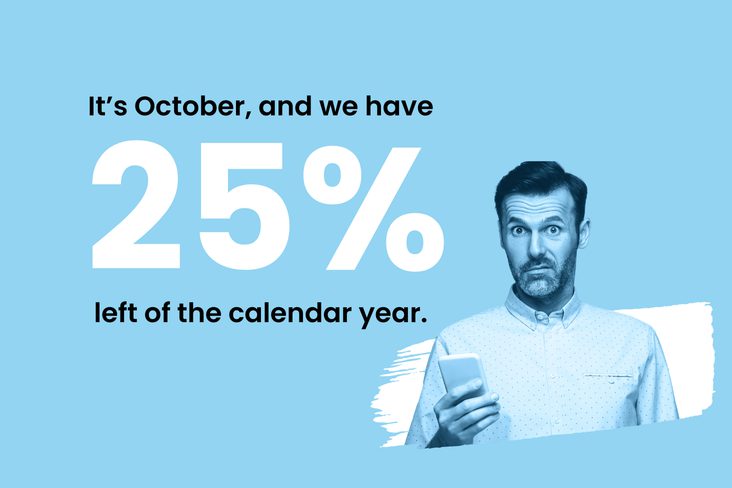
In this article
Quick takeaways
- You can double your time off in 2026 by planning your annual leave around these public holidays and weekend dates in the UK and Ireland.
- Managers can use these dates to plan for peak leave periods, such as Easter, Christmas and school holidays. Creating fairness with cover, and avoiding a surge of requests.
- Using a great leave management system you can navigate the busy period, set limits for requests, and track all absences to avoid being caught short-staffed.
Make your holidays stretch further in 2026
It’s that time of year again! Instead of just wishing for more time off, why not make the most of the leave you do have?
While we can’t stop time (even us calendar wizards aren’t that good), we can help you stretch it further with a little leave planning magic.
Those in the know will already be familiar with leave stacking, where you ‘stack’ your annual leave by booking strategic dates to stretch your time off around existing public holidays and weekends to turn days into weeks. Clever, right? The total number of consecutive days off you can take varies from year to year, depending on which days of the week key holidays fall on. So let’s see what 2026 has in store.
For savvy managers, understanding the dates when people are most likely to request time off can help them prepare for what’s ahead, ensure everyone gets the chance to maximise time off, plan staff cover, and prevent a bottleneck of leave requests.
This technique relies on public holidays – you book your annual leave immediately before and/or after a public holiday. These helpfully always fall on a Monday or Friday – this is the source of the most treasured of all British traditions, the bank holiday weekend. But what’s better than a long weekend? A full week!
England and Wales Bank Holidays
A few caveats before we get started:
1. Some employers include bank holidays within the 28 days that all UK workers are entitled to – you can still stack, but it won’t be as beneficial.
2. The number of public holidays (and some of the dates) varies across the four nations of the UK.
Calendars at the ready? Let’s mark some dates.
There are eight bank holidays in England and Wales in 2026:
- New Year’s Day: Thursday 1 January
- Good Friday: Friday 3 April
- Easter Monday: Monday 6 April
- Early May bank holiday: Monday 4 May
- Spring bank holiday: Monday 25 May
- Summer bank holiday: Monday 31 August
- Christmas Day: Friday 25 December
- Boxing Day: Monday 28 December (substitute day)
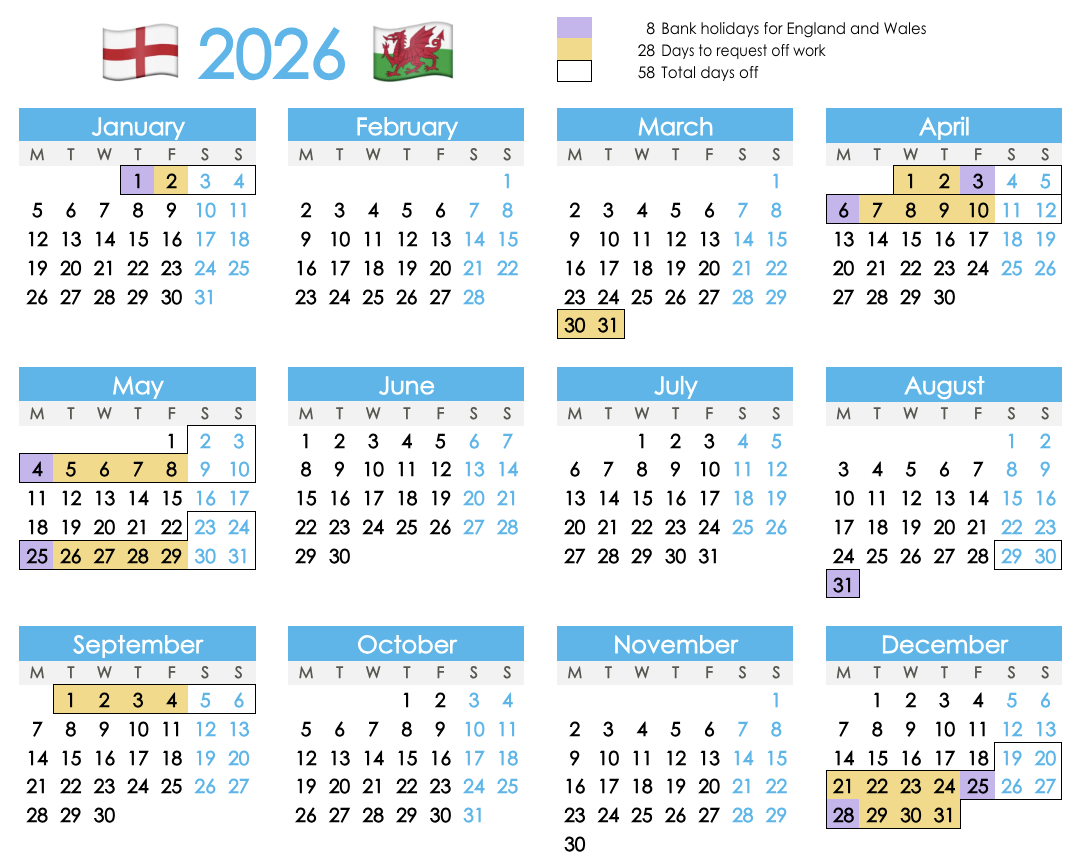
But those jammy workers in Scotland get an extra day, and in Northern Ireland, there’s a whopping ten public holidays in 2026 – the luck of the Irish! Here are the dates for Scotland, Northern Ireland and Ireland:
Scotland Bank Holidays
Scotland has nine bank holidays in 2026:
- New Year’s Day – Thursday 1 January
- Friday 2 January
- Good Friday – Friday 3 April
- Early May Bank Holiday – Monday 4 May
- Spring Bank Holiday – Monday 25 May
- Summer Bank Holiday – Monday 3 August
- St Andrew’s Day – Monday 30 November
- Christmas Day – Friday 25 December
- Boxing Day – Monday 28 December (substitute day)
This means the Scots can get 62 days off work by requesting 27 days of annual leave.
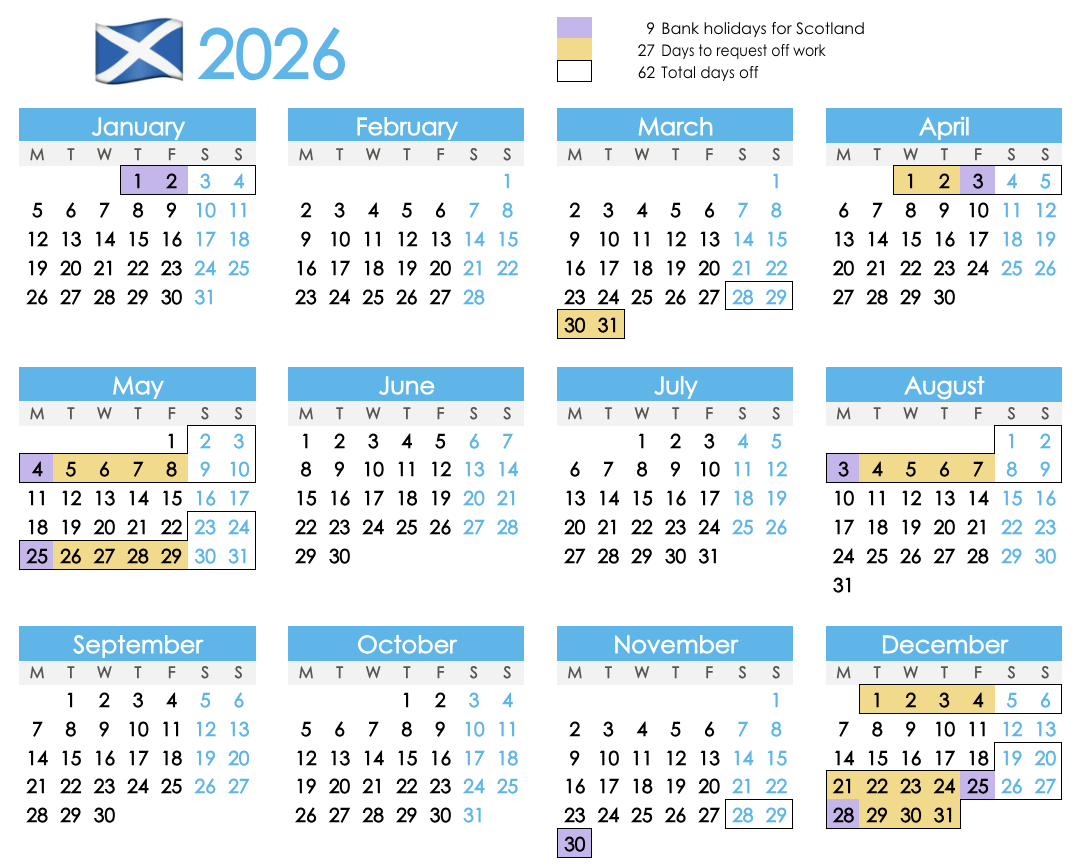
Northern Ireland Bank Holidays
In Northern Ireland, you can get 77 days off work by requesting 36 days of leave, as you have ten bank holidays in 2026:
- New Year’s Day – Thursday 1 January
- St Patrick’s Day – Tuesday 17 March
- Good Friday – Friday 3 April
- Easter Monday – Monday 6 April
- Early May Bank Holiday – Monday 4 May
- Spring Bank Holiday – Monday 25 May
- Battle of the Boyne (Orangemen’s Day) – Monday 13 July
- Summer Bank Holiday – Monday 31 August
- Christmas Day – Friday 25 December
- Boxing Day – Monday 28 December
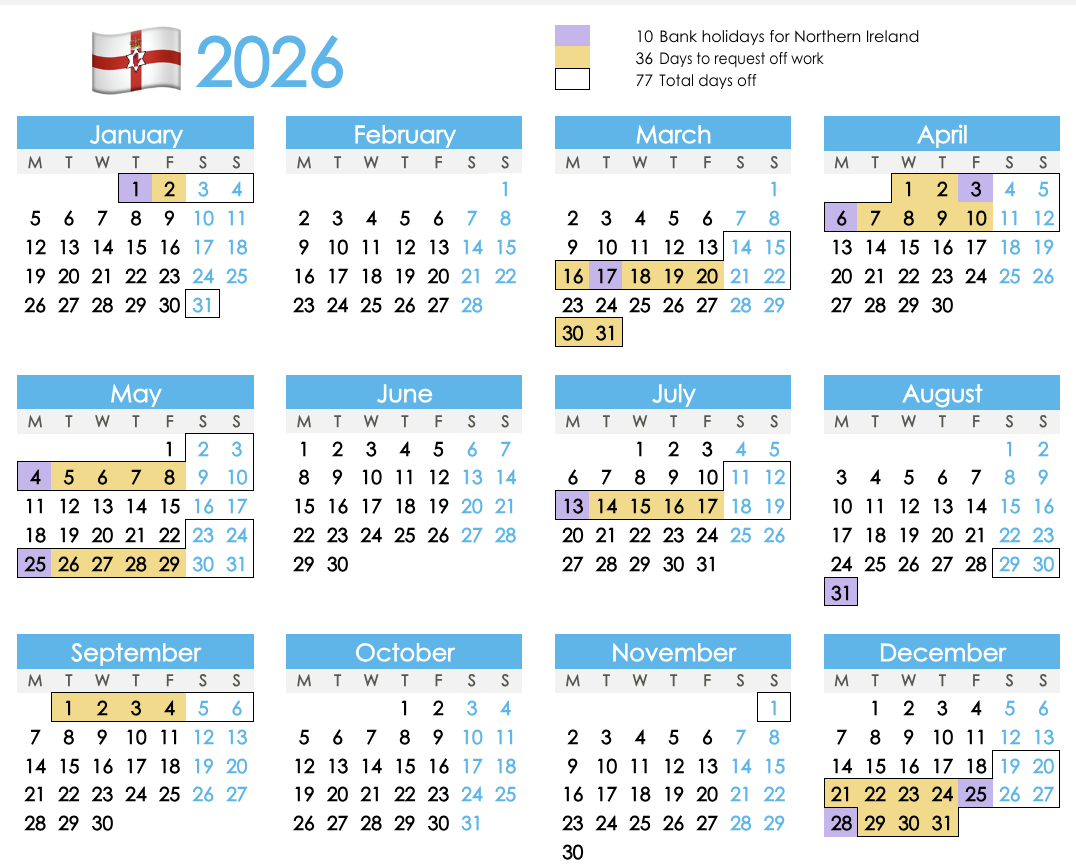
Ireland Bank Holidays
If you’re lucky enough to be living in this part of the Emerald Isle, you can get a huge 79 days off work by requesting 36 days of leave by booking around ten public holidays. We’re doing a jig just thinking about it.
Bank holidays in 2026:
- New Year’s Day – Thursday 1 January
- St Brigid's Day – Monday 2 February
- Saint Patrick’s Day – Tuesday 17 March
- Easter Monday – Monday 6 April
- May Day – Monday 4 May
- June Bank Holiday – Monday 1 June
- August Bank Holiday– Monday 3 August
- October Bank Holiday – Monday 26 October
- Christmas Day – Friday 25 December
- Saint Stephen's Day – Monday 28 December (substitute day)
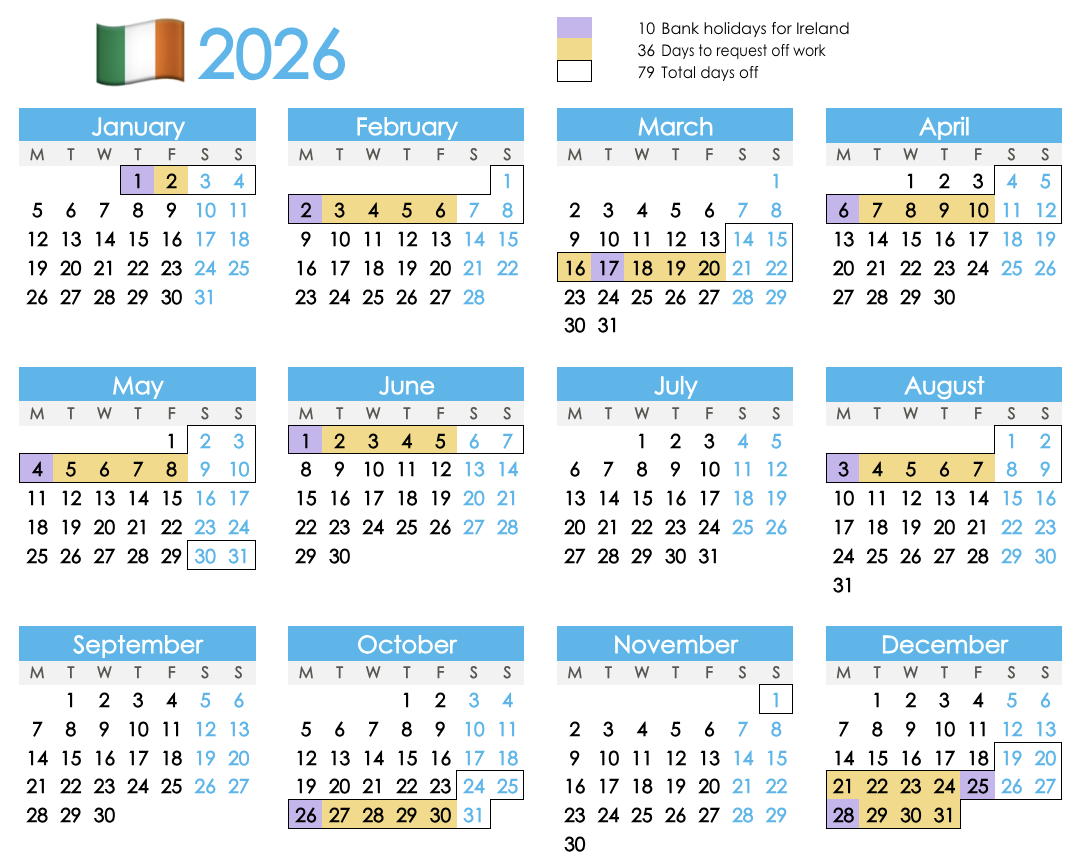
Dates to book off in 2026
As ever, the big hitters are January, March/April, May, August/September and December – that’s Easter, spring/summer bank hols, and Christmas/New Year. Taking the England and Wales dates as an example, here’s how to stack your leave for the longest breaks from work:
January 2026: Book 1 day off (Friday 2nd) after the New Year bank holiday for 4 consecutive days off (Thurs 1 Jan – Sun 4 Jan).
Top tip: if you’ve still got leave for 2025 remaining, you can add 3 days (29, 30 and 31 December 2025) from this year to give yourself a juicy 11 consecutive days off from Christmas Day ‘25 to 4 January ‘26.
March & April 2026: Book two sets of 4 days off (Monday 30 March to Thursday 2 April, then Tuesday 7 April to Friday 10 April) for 16 consecutive days from Saturday 28 March to Sunday 12 April.
- May 2026: Book 4 days off (Tues 5 to Friday 8 May) for 9 consecutive days (Sat 2 to Sunday 10 May), then another 4 days (Tues 26 to Friday 29 May) for another 9-day break (Sat 23 to Sunday 31 May).
- August & September 2026: Book 4 days off (Tues 1 to Friday 4 September) for 9 consecutive days (Sat 29 August to Sun 6 September). Parents, depending on your term dates, this might even give you a few holiday days to actually relax after the kids have gone back to school – imagine that!
- December 2026: Book 4 days off (Monday 21 to Thurs 24 December) for 10 consecutive days (Sat 19 December Monday 28 December). Then, to really ring in 2027 in style, take your final 3 days’ annual leave on 29, 30 and 31 December to turn that 10 days into 16. (Scottish workers will also get Monday 4 January off, a 17-day extravaganza!)
You’ll see from the above that Christmas Day 2026 is a Friday, which means Boxing Day actually falls on a Saturday, a non-working day for most 9-to-5ers. Fortunately, Scrooge doesn’t work in HR and we get a substitute public holiday on Monday 28 December.
Even better, this means if you book seven days’ leave at the end of December you get a whopping 16 days’ consecutive time off to see out 2026 as New Year’s Day falls on a Friday too. That means you’ll start work in 2027 on 4 January after a fortnight of festive fun, and a few days to recover.
Leave stacking in the school holidays
Of course, the use of public holidays as anchor dates means that to get the most out of your leave, you give up flexibility. You will also have to confront the elephant in the room – school holidays. For parents, it’s great news as most of these dates fall in and around school holidays, so tactical use of annual leave will go some way to covering the vast and expensive gulf in childcare outside of term time.
To be honest, if you’re a parent then this ‘hack’ is probably not news to you, and will be one of many tools already in your childcare juggling arsenal. If you work with lots of other parents, you’ll need to get in there quick!
For non-parents, if you’re planning to go abroad or, god forbid, Center Parcs, bankruptcy is of course a risk. The main downside of the leave stacking approach is that it ties you to those classic ‘holiday’ dates, which tend to come with a larger price tag if you’re booking hotels and flights. But for double the leave, it might just be worth it.
Note for managers: Plan ahead for stacked leave.
Bank holidays are like anchor points for employees to maximise time off, so these dates are worth planning around. There is a good chance that you will get multiple requests around these periods, so here are some things to keep in mind:
The leave request rush: Easter, summer and Christmas are the prime periods for leave stacking, so encourage your team to consider the year ahead and get their requests in early.
Consider fairness as well as business needs: Whether you have a first-come, first-served system, reserve priority for someone who hasn’t taken leave in a long time, or a rotating system, be sure to communicate this with your staff.
- Use a system like Leave Dates to make peak periods easy to navigate. Using Leave Dates you can set leave limits for any period to limit the number of staff absent at once, see your team’s leave schedule on the wall chart and spot potential issues long before they happen.
Visibility and communication are essential during periods where annual leave requests will flock in. Planning is essential to avoid being short-staffed and to ensure everyone gets the rest they need.
Sit back, relax, and let us calculate your leave.
Leave Dates automatically calculates all your staff leave — no spreadsheets, no manual maths, just accurate data at your fingertips.
Final thoughts
We all have the same 28 days minimum a year… Well, give or take. With our help, you can double your ‘leave’ in 2026, for double the sun (in theory) and double the fun (guaranteed)! Of course, knowing the dates isn’t enough – you’ve got to get there first if you want to take full advantage of this clever trick.
It’s simple maths, which means we won’t be the only ones who’ve figured this out, so make sure you get in quick before the requests start piling up. We’ve done the hard work for you in working out the dates for next year, so stop looking and start booking!
Whether you go the whole hog and stack all your 2026 leave to get maximum benefit, or just use it to get one longer break in the diary and keep the rest flexible, is up to you. But with 30 or more extra days on the table, a bit of forward-planning could make 2026 the year you finally nail that work–life balance and get the downtime you need.
FAQs
Plan your leave for the days before or after a bank holiday, ensuring you have time off for both weekends. For example, in England and Wales, the Early May Bank holiday is on Monday, 4th May. If you book annual leave from the 5th to the 8th of May, you will bridge the bank holiday weekend with the following weekend, giving you nine consecutive days off. This technique is known as 'leave stacking', and it's a great way to get more consecutive days off without using all of your leave days.
Christmas is the best time to make the most of your leave allowance (and if your leave doesn’t roll over to the next calendar year, it might be a last chance too). Booking time off from the 21st to the 24th, and 29th to the 31st of December, you can have 13 consecutive days. Also, the 1st January is a Friday in 2027, so you automatically have 16 days, or 17 if you’re in Scotland.
In the UK, employees are entitled to 5.6 weeks of paid annual leave, which may or may not include bank holidays, depending on your employer’s policy. If bank holidays are included in your allowance, you will have a bit less wiggle room, but by using the leave stacking technique explained above, you can plan your time off strategically. Whether your leave carries over or not is also dependent on your employer's policy. Generally, employees are required to take a minimum of 4 weeks of leave per year or risk losing it when the year rolls over. The remaining 1.6 weeks, or more if your employer offers it, can be rolled over to the next leave year.



